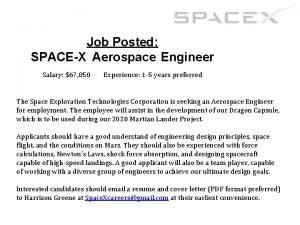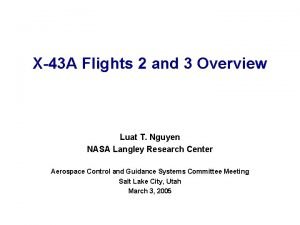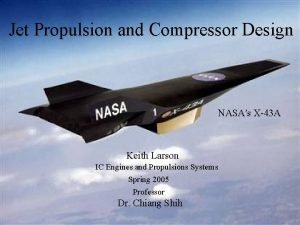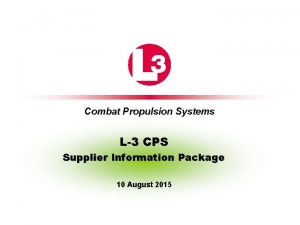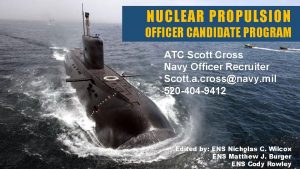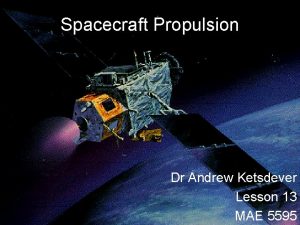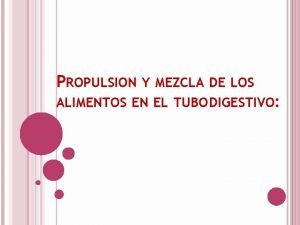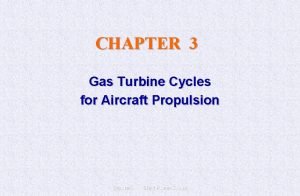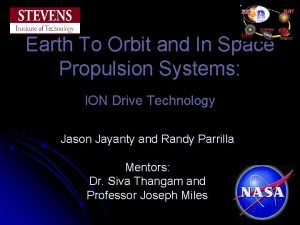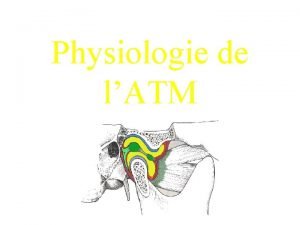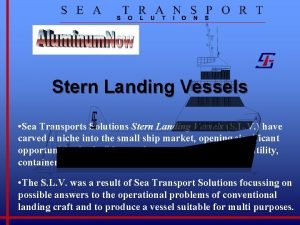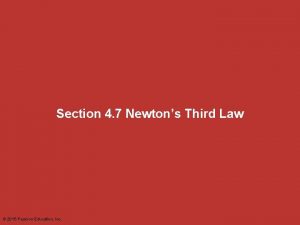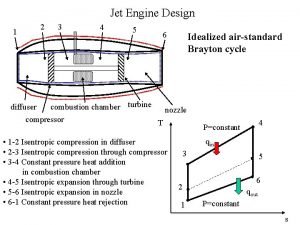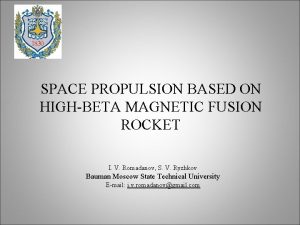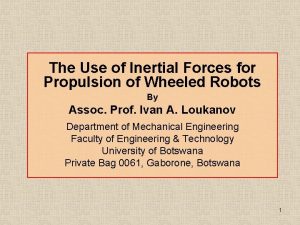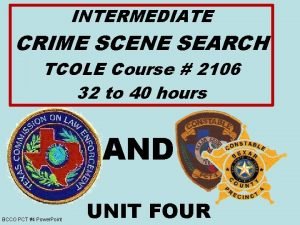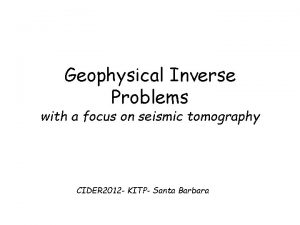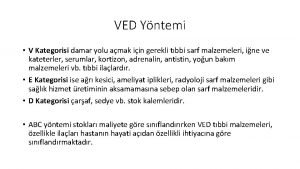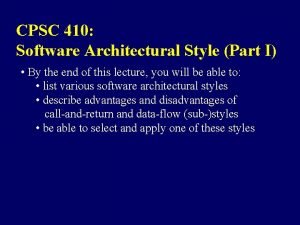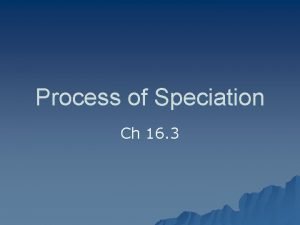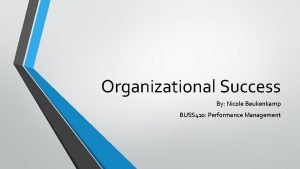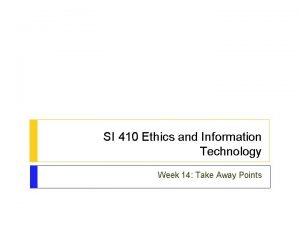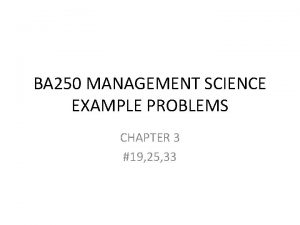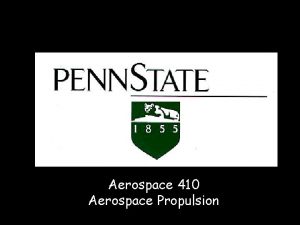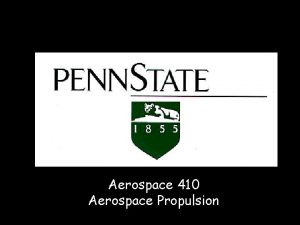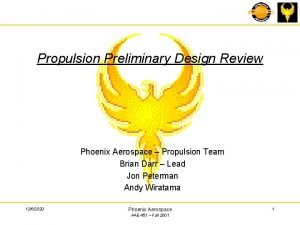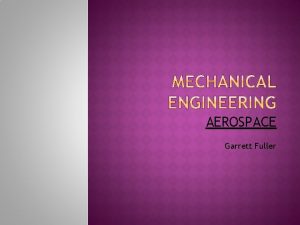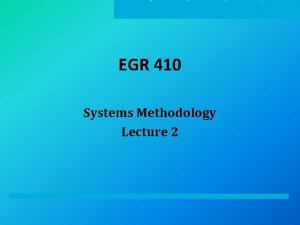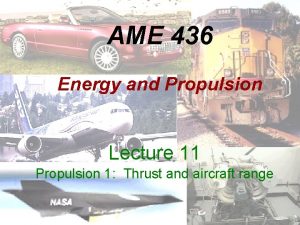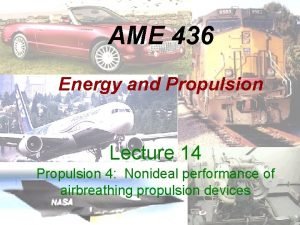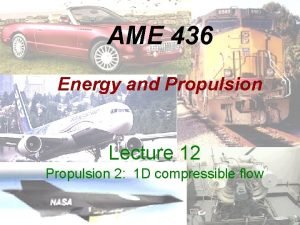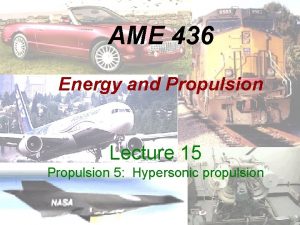AEROSPACE 410 AEROSPACE Lecture PROPULSION HYPER X X43


































- Slides: 34


AEROSPACE 410 AEROSPACE Lecture PROPULSION HYPER X X-43 project NASA SCRAM-JET TESTS Using a rocket booster from ORBITAL SCIENCES INC. Dr. Cengiz Camci


NASA's X-43 Could Some Day Chase Mach 10 CAPE CANAVERAL An experimental aircraft expected to fly 10 times the speed of sound is set to begin tests next month above the Pacific Ocean. If it works, NASA could finally have the blueprint for a spacecraft that takes off and lands like an airplane.

SCRAMJET is development the same kind of shift as the jet engine over the propeller engine, " Hyper-X Program Manager Vince Rausch said Wednesday. The 12 -foot- long shovel-shaped aircraft relies on a revolutionary engine called a scramjet for its hypersonic speed. Instead of using a rotating compressor to compress air, the aircraft's high speed forces air into the engine where it is mixed with fuel and burned. A scramjet uses the surrounding air instead of carrying its own oxidizer like the space shuttle and other rockets. This saves tremendous weight while still allowing the speed necessary to reach orbit.

The scramjet has no moving parts, but only works at very high speeds. By comparison, the record-setting X-15 rocket plane reached almost Mach 7 in the 1960 s. The unmanned X-43 will not start its engine until it hits Mach 7. To get there, it will ride a winged Pegasus rocket dropped from a B-52. NASA used the same B-52 to drop manned X-15 s, which held speed records until the space shuttle flew in 1981. The $185 million X-43 program will fly three tests this year, each with a different aircraft. The first will be a 10 -second scramjet burn at Mach 7 followed by a fast glide and splashdown in the Pacific. The last is targeted to reach Mach 10, or more than 2 miles (3. 2 kilometers) a second.

Once launched, the X-43 A was designed to then fire its specialized engine -- called a scramjet -- and fly under its own power for 10 seconds, covering about 17 miles. It will then coast to an impact in the water. NASA had hoped the plane would reach speeds Approaching Mach 7 during its fleeting flight, besting the Mach 6. 7 record set by the rocket-powered X-15 in 1967.






















EARLY JUNE 2001





 Spacex software engineer salary
Spacex software engineer salary X43 a
X43 a X43 jet
X43 jet 01:640:244 lecture notes - lecture 15: plat, idah, farad
01:640:244 lecture notes - lecture 15: plat, idah, farad Combat propulsion systems
Combat propulsion systems Nupoc salary
Nupoc salary Propellantless propulsion
Propellantless propulsion Propulsión en el sistema digestivo
Propulsión en el sistema digestivo Turbojet vs turbofan
Turbojet vs turbofan Nuclear thermal propulsion
Nuclear thermal propulsion Satellite propulsion system
Satellite propulsion system Paris stylo enchanted
Paris stylo enchanted Stern landing vessel propulsion
Stern landing vessel propulsion Squid use jet propulsion for rapid escapes
Squid use jet propulsion for rapid escapes Nuclear propulsion
Nuclear propulsion Propulsion efficiency
Propulsion efficiency Vasimr
Vasimr Inertial propulsion drive
Inertial propulsion drive Svsd 410
Svsd 410 What is cross projection sketch
What is cross projection sketch Gmayag
Gmayag Cse 410
Cse 410 6-12/410
6-12/410 Ved yöntemi nedir
Ved yöntemi nedir Si 410
Si 410 David stotts unc
David stotts unc Cpsc 410
Cpsc 410 Section 16–3 the process of speciation (pages 404–410)
Section 16–3 the process of speciation (pages 404–410) Logaritma negatif
Logaritma negatif Army skl
Army skl Buss 410
Buss 410 Si-410
Si-410 Barracuda web filters
Barracuda web filters Ipm 410-3 (shikha) price
Ipm 410-3 (shikha) price The bradley family owns 410 acres
The bradley family owns 410 acres
